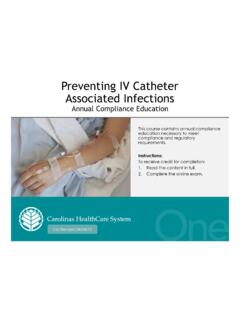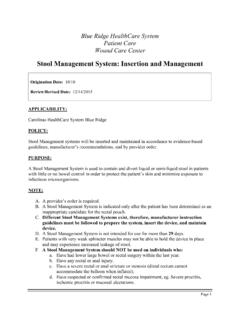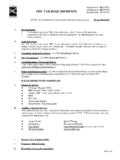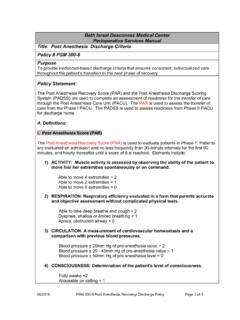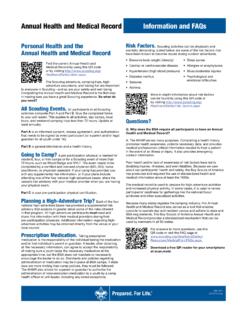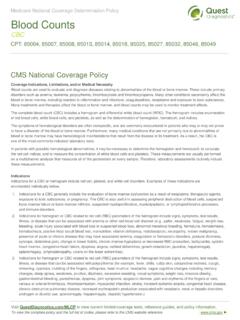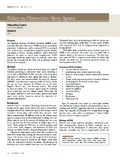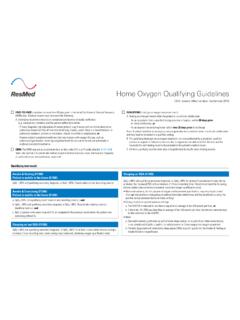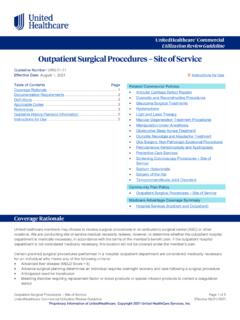Transcription of Moderate (Conscious) Sedation Protocol
1 Moderate (Conscious) Sedation ProtocolPrepared byDept of AnesthesiologyJamie Doyle, MDGene Tom, MDCopyright 2005 Southeast Anesthesiology Consultants, Sedation definitions Pre operative evaluation Drugs utilized Airway managementCopyright 2005 Southeast Anesthesiology Consultants, Sedation Does not mandate implementation of Conscious Sedation Policy Patient maintains Normal respiration Normal eye movement Normal response to command, and Normal or baseline mental orientationCopyright 2005 Southeast Anesthesiology Consultants, Sedation Protective reflexes are intact Airway remains patent Spontaneous ventilation is adequate Patient responds to physical stimulation or verbal command No adverse effect on cardiorespiratory functionCopyright 2005 Southeast Anesthesiology Consultants, Sedation Use of medication to induce a level of depressed consciousness from which the patient is not easily aroused Can result in partial or complete loss of protective airway reflexes Need for airway support Beyond the scope of this policyCopyright 2005 Southeast Anesthesiology Consultants.
2 Operative Evaluation of Cardiopulmonary Diseases Patients with Moderate to severe heart or lung disease will have decreased ability to tolerate deviations from normal levels of consciousness They can easily decompensate during mild hypoxia or hypercarbia Consider Anesthesiology consult for such patientsCopyright 2005 Southeast Anesthesiology Consultants, Society of Anesthesiologists Classification ASA 1 : No health problems. ASA 2 : Mild to Moderate systemic disease ASA 3 : Severe systemic disease ASA 4: Severe systemic disease that is a constant threat to life ASA 5: Moribund patient not expected to survive without procedureCopyright 2005 Southeast Anesthesiology Consultants, Assessment Mallampati class Difficult airway anatomy History of difficult intubation Disease states associated with a difficult airwayCopyright 2005 Southeast Anesthesiology Consultants, ClassificationClass I: can see soft palate, entire uvula, tonsils, & posterior pharynxClass III: can see soft palate & base of uvulaClass II: can see soft palate, part of uvula, & posterior pharynxClass IV.
3 Can see hard palate onlyClass III or IV suggests a difficult intubationDiseases with Difficult Airways Acquired Obesity/Sleep apnea Rheumatoid arthritis Ankylosing spondylitis Airway tumors Airway infections Acromegaly Burn patients Congenital Pierre Robin Treacher Collins Down s syndrome Goldenhar sCopyright 2005 Southeast Anesthesiology Consultants, Airway Anatomy Short/fat neck Decreased mobility of the airway joints Dental overbite or small mandible Large tongue Distortion in the airway (extrinsic or intrinsic)Difficult anatomy may make mask/bag ventilation difficult or impossibleCopyright 2005 Southeast Anesthesiology Consultants, GuidelinesAgeSolids/Breast Milk/FormulaClearLiquids0-6 months4 hours2 hours6 months-adult6 hours2 hoursCopyright 2005 Southeast Anesthesiology Consultants, Anesthesiology Consults Patient has failed conscious Sedation in past Medically or psychologically unstable (ASA class III, IV, V) Complicated airway (MP class III or IV, difficult anatomy)
4 Patients with recent oral intake Pregnant patientsCopyright 2005 Southeast Anesthesiology Consultants, Sedation Risks Respiratory depression Loss of airway Vomiting/aspiration ArrhythmiasCopyright 2005 Southeast Anesthesiology Consultants, Sinus bradycardia: Sedation may cause a drop in heart rate Sinus tachycardia: may due to pain, hypoxia, or hypercarbia PVCs: may be due to hypoxia or hypercarbia SVTC opyright 2005 Southeast Anesthesiology Consultants, needed Pulse oximeter Oxygen source Ambu bag with mask and oral airway Laryngoscopes with Miller and Mac blades Endotracheal tubes with stylet Functioning suction with Yankauer tip ECG monitorCopyright 2005 Southeast Anesthesiology Consultants, needed Emergency Code Alpha Cart w/defibrillator Standard resuscitative drugs Anesthesia emergency drugs Narcan (naloxone) Romazicon (flumazenil) Succinylcholine (Anectine)Copyright 2005 Southeast Anesthesiology Consultants, procedure monitoring SaO2(via pulse oximetry) Blood pressure EKG monitor (rhythm & rate)
5 Respirations Level of consciousnessCopyright 2005 Southeast Anesthesiology Consultants, Saturation CurvePaO2(mmHg)O2saturation(%)3060%4075% 6090%The steep part of curve occurs at 90% O2sat. resulting in a rapid drop in procedure Patient should be responsive to physical and verbal stimuli at all times If unresponsive, patient has become deeply sedated Stop procedure Initiate appropriate airway management Defer further administration of sedatives until patient returns to Moderate sedationCopyright 2005 Southeast Anesthesiology Consultants, ObstructionLoss of airway muscle tone in anesthesized patient leads to obstructionAirway Obstruction: Recognition Respirations Labored Paradoxical chest movement Tachypnea Inspiratory stridor Snoring (partial), No breath sounds (complete) Decreased O2satsCopyright 2005 Southeast Anesthesiology Consultants, Obstruction: Recognition Neuro.
6 Restlessness, decreased mental status, unconscious Skin: Cyanosis Vitals: Tachycardia, bradycardia, hypertensionCopyright 2005 Southeast Anesthesiology Consultants, handed Mask TechniqueFor airway maintenance consider:-raising head position-head extension/chin lift-jaw thrust-oral or nasal airway placementTwo handed Mask TechniqueWith one person to squeeze ventilation bag and the other to obtain proper mask fit(When patient is difficult to mask/bag ventilate)Benzodiazepines Produce amnesia, Sedation , anxiolysis Anticonvulsants Minimal effects on circulation Diazepam (Valium) T1/2is 25 30 hours Lorazepam (Ativan) T1/2is 10 20 hours Midazolam (Versed) T1/2is 1 4 hoursCopyright 2005 Southeast Anesthesiology Consultants, (Versed) Dosing: mg/kg For 70 kg patient: 2 mg incrementally; max of 7 mg 1 3 minutes onset.
7 Clinical duration: ~ 20 40 minutes No pain on injectionCopyright 2005 Southeast Anesthesiology Consultants, (flumazenil) A benzodiazepine receptor antagonist Treat overdoses of benzodiazepines with mg IV per minute (maximum single dose is 1 mg) Rapid reversal with large boluses may result in arrhythmias, hypertension, aggitation or seizuresCopyright 2005 Southeast Anesthesiology Consultants, Drugs that bind to opioid receptors and produce Analgesia desired effect Euphoria clinically useful but potentially dangerous Respiratory depression depresses medullary ventilation centers. Other side effects: Nausea, pruritis, orthostatic 2005 Southeast Anesthesiology Consultants, Opioids (morphine, Demerol, fentanyl) produce a rapid and sustained dose dependent depression of ventilation.
8 They depress the medullary respiratory drive centers response to CO2. The CO2response curve is shifted to the right, ie, a higher CO2is required to stimulate ventilation. Copyright 2005 Southeast Anesthesiology Consultants, Response Curve to NarcoticsFactors that Potentiate Respiratory Depression Drugs COPD Obesity Obstructive Sleep ApneaCopyright 2005 Southeast Anesthesiology Consultants, Opioids do not reliably produce unconsciousness but they can make a semi conscious patient apneic. It is possible to have a patient that responds to stimuli (voices, sternal rub) but will not 2005 Southeast Anesthesiology Consultants, : Some dosing Guidelines Morphine : mg/kg max of mg / 70 Kg patient : mg, max of 7 mg Mederidine (Demerol): mg / mg, Max 50 100 mg Fentanyl : 1 2 mcg / kg, max 3 mcg / kgCopyright 2005 Southeast Anesthesiology Consultants, : Agonist / Antagonists Nubain partially stimulates some opioid receptors and inhibits others.
9 There should be a ceiling on the analgesia and respiratory depression, after mg / Kg ( max 10mg ) is administered, no further analgesia nor respiratory depression SHOULD occur. However, clinically significant respiratory depression CAN OCCUR. Can precipitate severe withdrawal symptoms or a pain crisis (if on chronic pain meds)Copyright 2005 Southeast Anesthesiology Consultants, (Narcan) A pure narcotic agonist that reverses the respiratory depression caused by narcotics Reverses respiratory depression AND analgesic effects of opioids Rapid reversal with a large bolus is undesirable Titrate mg mg to effect Half life about 30 min Pulmonary edema, narcotic withdrawal symptoms, and pain crisis (if on chronic opioids) are possibleCopyright 2005 Southeast Anesthesiology Consultants, with Benzodiazepines Versed and Fentanyl together with have a synergistic effect on Sedation and respiratory depression.
10 Use extreme caution when using these two drug families together !!!!!Copyright 2005 Southeast Anesthesiology Consultants, anesthetics for infiltration Bupivicaine Max dose 3 mg/kg (max total = 250 mg) Increased cardiac toxicity vs other local anesthetics Lidocaine Max dose : 3 4 mg / kg without epinephrine When injected with epinephrine : 5 7 mg / kg Max dose = 500 mgCopyright 2005 Southeast Anesthesiology Consultants, Anatomical Airway Differences Large head Large tongue Short neck Larynx more cephalad Epiglottis long and stiff Cricoid is narrowest part of airway ETT may pass larynx but not trachea Narrow tracheaCopyright 2005 Southeast Anesthesiology Consultants, AirwayWhy am I a difficult airway?Pediatric Sedatives Oral Agents Chloral Hydrate: This drug should NOT be given at home.


